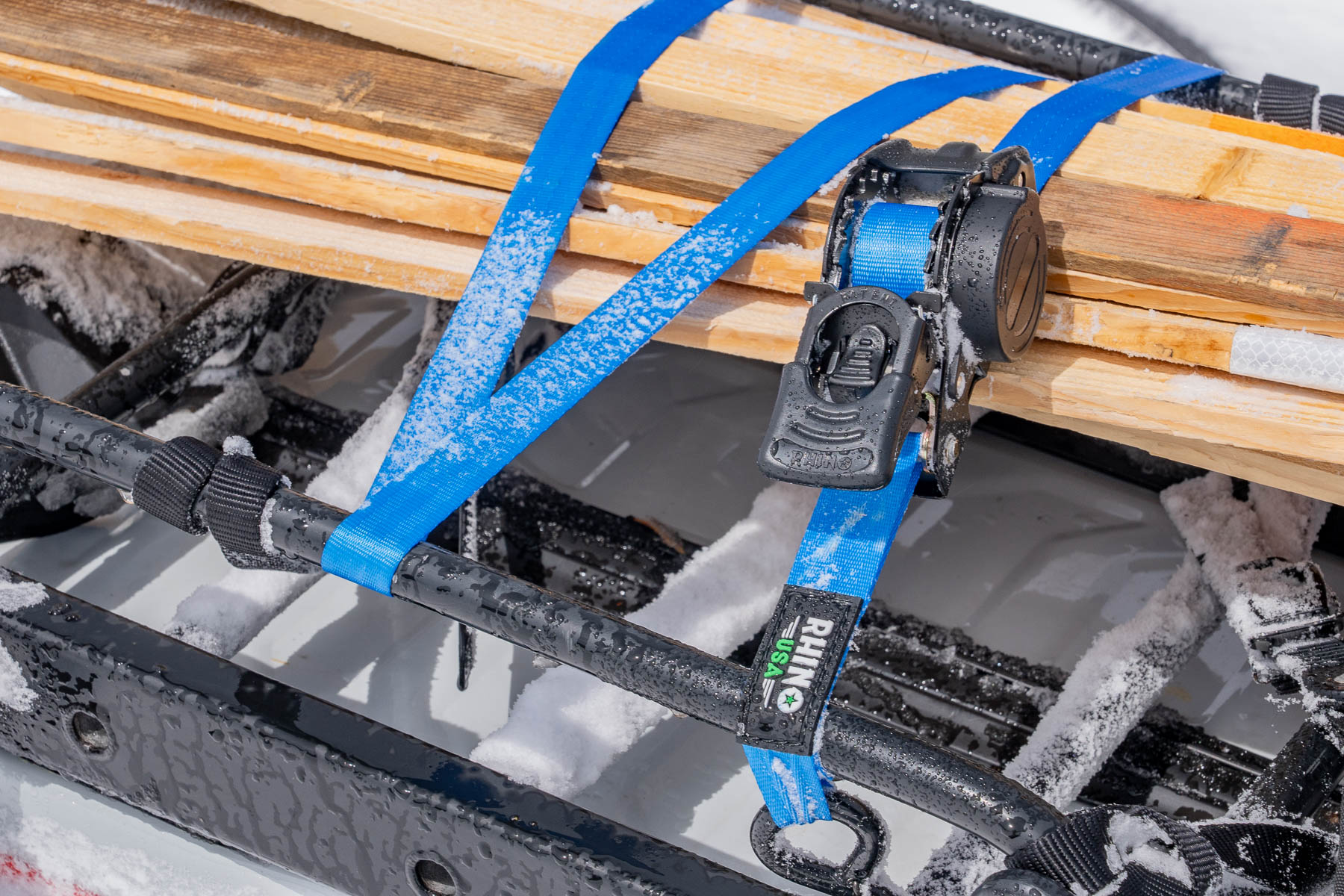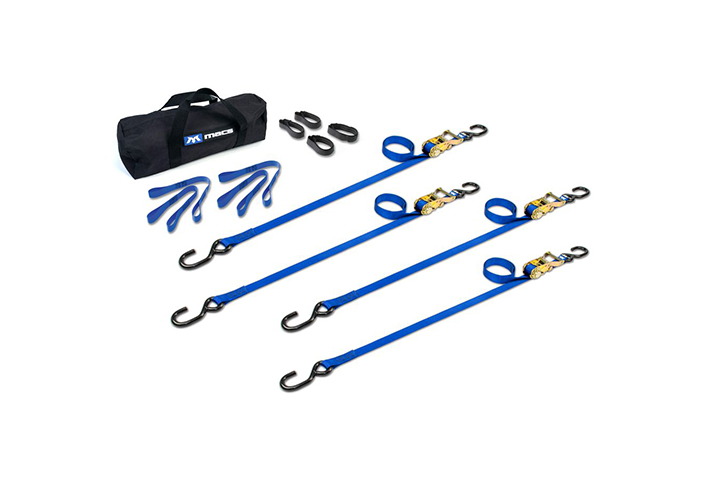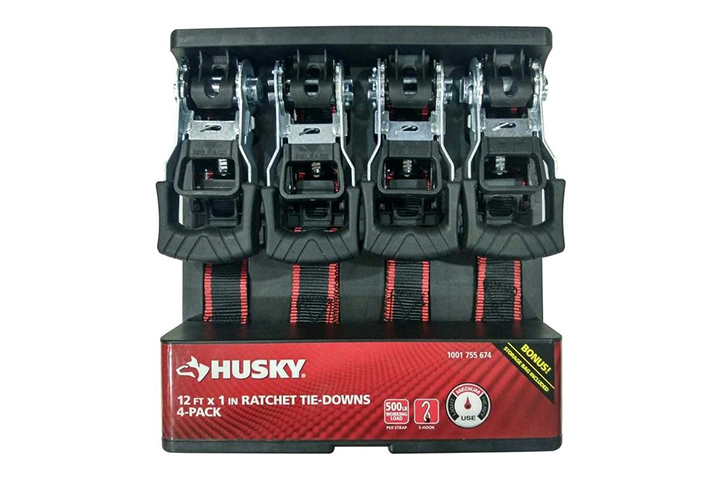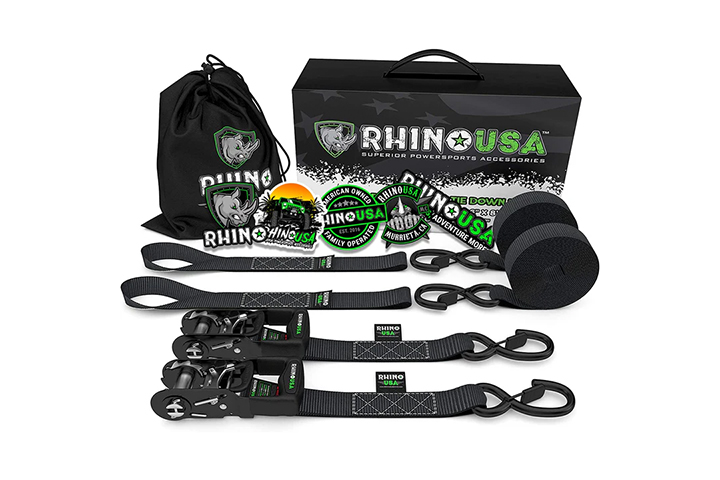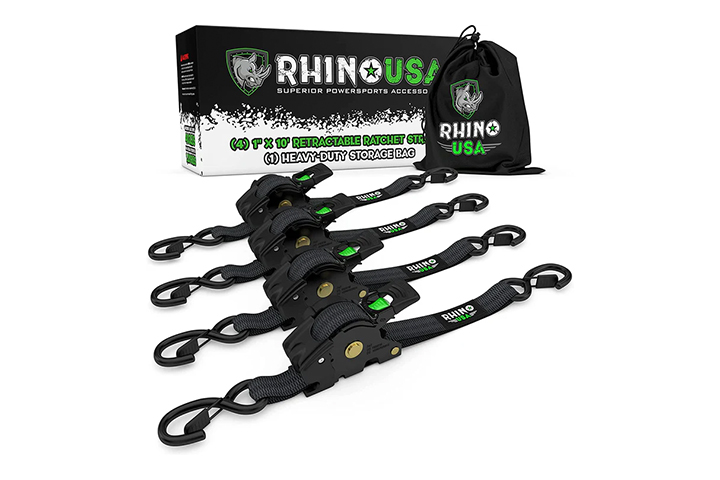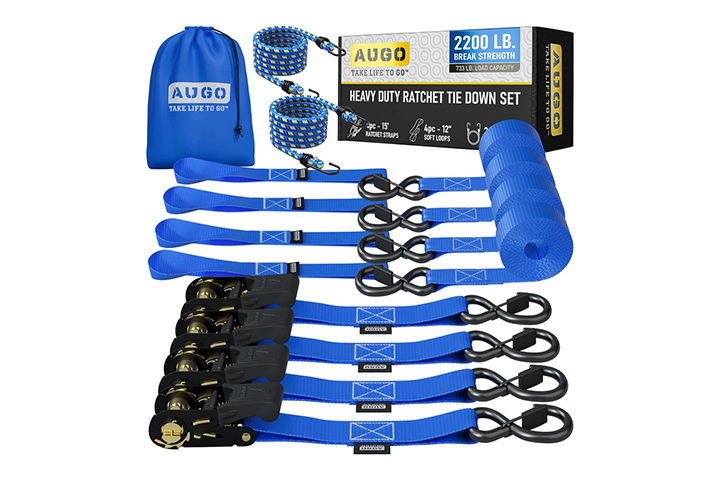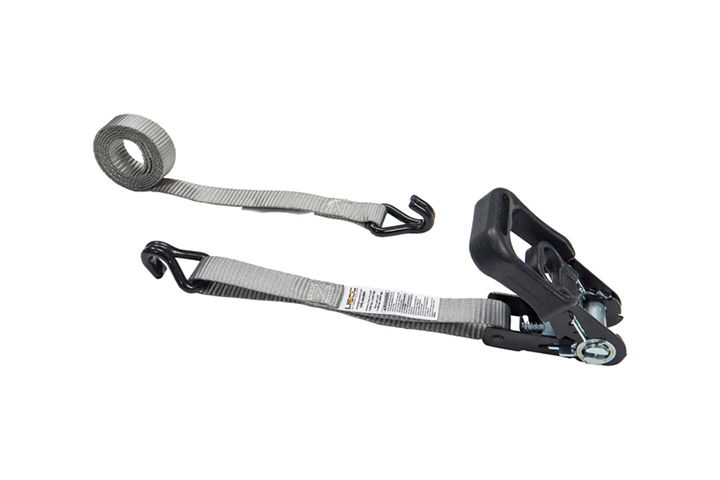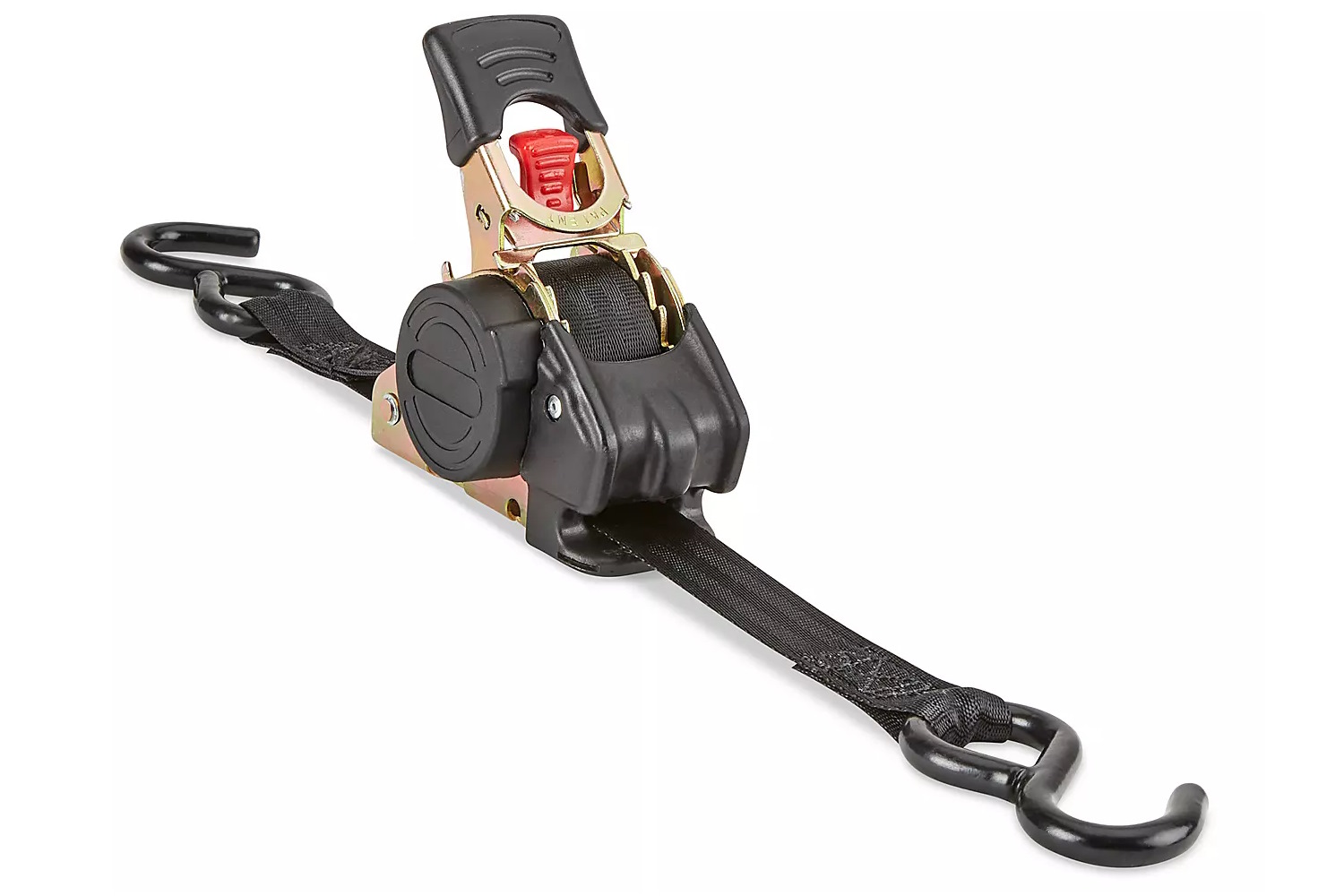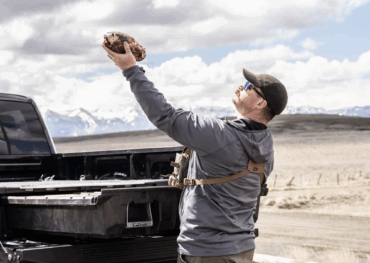We take our gear on lots of trips. And we can bet that you do, too — meaning you, too, need a collection of ratchet straps. As gear gets larger — from hard coolers and standup paddleboards to motorcycles — it’s even more essential to secure loads during transport.
Ratchet straps have the ability to tighten down and securely hold a load. There are a ton of options on the market for ratchet straps of all different strengths, sizes, and attachment variations. Some of them clutch into the thousands of pounds like the Rhino Rack HD Ratchet Tie-Down Set. You can even customize the length, color, and end fittings of the Mac’s Custom Tie-Downs. Both sets are great for securing an array of objects across a variety of platforms, be it a truck bed or rack. Then, you can dispense the cargo with a simple release.
In this guide, we cover various details including types of ratchets, max strengths, working loads, end attachments, tie-down accessories, length, and more. We dug through the internet to find the best ratchet straps available and put them to the test, attempting to abuse them in all aspects and seasons of our outdoor testing grounds in Southwest Colorado. To learn more about the features of ratchet straps and a more in-depth analysis of how these straps can vary, be sure to check out the Buyer’s Guide or jump to the Price & Value summary. Still weighing your options? Consult our Comparison Chart to see how straps stack up. Otherwise, take a look at our awarded goods.
Editor’s Note: We updated our Ratchet Straps buyer’s guide on October 27, 2024, to include the Uline Retractable Tie Downs 1″ x 10′.
The Best Ratchet Straps of 2025
Mac’s Custom Tie-Downs
- Width: 1”
- Breaking Strength: 2,800 lbs
- Work Load Limit: 933 lbs
- Material: Nylon
- Lengths: 6’, 10’
- Colors: Blue, black, pink, red, orange, silver, purple, yellow, green
Pros
- Most thorough instructions and safety specs
- Nicest canvas storage bag and strap bands
- Multiple end fittings and color options
Cons
- Priciest option tested
- Non rubber handle
Husky Ratchet Tie-Downs 4-Pack
- Width: 1”
- Breaking Strength: 1,500 lbs
- Work Load Limit: 500 lbs
- Material: Polyester
- Lengths: 12’
- Colors: Black with red stripes
Pros
- Priced affordably
- Rubber-coated handles
- Comes with carrying bag
Cons
- Only 500-pound breaking strength
- Shows wear quickly
Rhino Rack HD Ratchet Tie-Down Set
- Width: 1.6”
- Breaking Strength: 5,208 lbs
- Work Load Limit: 1,736 lbs
- Material: Polyester, silk
- Lengths: 8’
- Colors: Black, green, blue, orange, red, grey
Pros
- High breaking strength and workload
- Large rubber-coated ratchet handles
- Large S-hooks with gates
- Includes pair of matching soft shackles
Cons
- Gates often won’t easily close due to their large size
- Flimsy storage bag
Rhino Rack Retractable Ratchet Straps
- Width: 1”
- Breaking Strength: 1,209 lbs
- Work Load Limit: 403 lbs
- Material: Polyester, silk
- Lengths: 10’
- Colors: Black, green, blue, orange, red, gray
Pros
- Smooth, user-friendly ratchet system
- Retractable design automatically coils extra slack
- Rubber handles
- S-hooks with gates
Cons
- Low breaking strength
- Bulky ratchet is heavier and takes up more space than traditional design
- Shows wear quickly
Augo Heavy Duty Ratchet Straps
- Width: 1”
- Breaking Strength: 2,200 lbs
- Work Load Limit: 733 lbs
- Material: Polyester
- Lengths: 15’
- Colors: Black, blue, green, grey, orange, red, yellow
Pros
- Full kit includes a bag, bungee cords, and soft shackles
- Compact design keeps unit light and small
Cons
- For a heavy-duty ratchet we would like to see a higher breaking strength
- Long tails without a way to easily secure them
US Cargo Control Ratchet Strap
- Width: 1”
- Breaking Strength: 3,300 lbs
- Work Load Limit: 1,100 lbs
- Material: Polyester
- Lengths: 6’, 10’, 15’, 20’
- Colors: Black, blue, grey, green, red, white, yellow
Pros
- High work-load limit
- Multiple end attachment options
- Bulk ordering available
Cons
- No rubberized handles
- Lacks extras like storage bags or soft shackles
- Width: 1”
- Breaking Strength: 1,200 lbs
- Working Load Limit: 400 lbs
- Material: Polyester
- Length: 6’, 10’
- Color: Black
Pros
- Very convenient no mess design
- Quality construction and materials
- Simple operation
Cons
- Roughly the same size and storage footprint as a standard ratchet strap
- Can be a little difficult to release with high tension
- Does not come with a storage bag
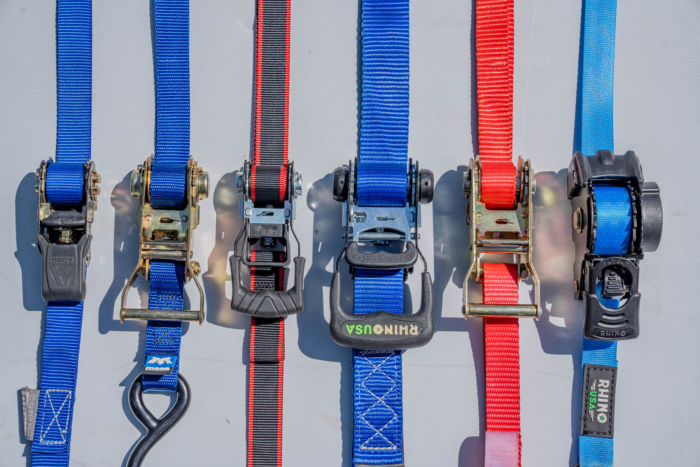
Ratchet Straps Comparison Chart
Scroll right to view all of the columns: Price, Breaking Strength, Work Load, Width, and Materials.
| Ratchet Strap | Price | Materials | Breaking Strength | Work Load Limit | Width |
|---|---|---|---|---|---|
| Mac’s Custom Tie-Downs | $80 | Nylon | 2,800 lbs. | 933 lbs. | 1” |
| Husky Ratchet Tie-Downs 4-Pack | $22 | Polyester | 1,500 lbs. | 500 lbs. | 1” |
| Rhino Rack HD Ratchet Tie-Down Set | $30 | Polyester, silk | 5,208 lbs. | 1,736 lbs. | 1.6” |
| Rhino Rack Retractable Ratchet Straps | $40 | Polyester, silk | 1,209 lbs. | 403 lbs. | 1” |
| Augo Heavy Duty Ratchet Tie-Down Straps | $30 | Polyester | 2,200 lbs. | 733 lbs. | 1” |
| US Cargo Control Ratchet Strap | $8 | Polyester | 3,300 lbs. | 1,100 lbs. | 1” |

How We Tested Ratchet Straps
Our Expert Testers
Our lead tester and photographer, Eric Phillips, has been an outdoor professional for the last 10 years and a hobby automotive enthusiast. From growing up working as a ranger for his local Boy Scout camp to volunteering search and rescue in Crested Butte, Colo., Phillips has used ratchet straps for a ton of different scenarios over the course of his career and daily life.
Gear tester, photographer, and all-around outdoor enthusiast Chip Jordan has plenty of experience using ratchet straps, ropes, and webbing — throughout the past 15 years, he’s worked as a full-time firefighter and spent eight years in the Army with two combat deployments, and now works as an NCCCO certified crane operator.
Our Testing Grounds
Our GearJunkie test team lives in the heart of the Rocky Mountains — Southwestern Colorado — and they like to recreate pretty hard. We also have automotive testers in neighboring New Mexico. When it comes to testing ratchet straps, we wanted to put these straps to the test by ramping up the seasonal volume to match that of a year in the field. From the exposure to snow and below-freezing alpine conditions to lengthy durations holding gigantic, heavy loads, these straps took a beating.
Our Testing Process
The fleet of test vehicles included a 2014 Ford F-150 Raptor, 2008 Ford F-250, 2007 Suzuki DRZ 400 motorcycle, and a 2022 Ski Doo Summit snowmobile. We used the straps to secure a range of oddly shaped objects, like hard coolers and lumber, to each vehicle. There were even a couple of paddleboards tossed in for good measure. We also strapped down the snowmobile and motorcycle to their respective trailers for transport.
Throughout our field tests and personal experience, we determined the best ratchet straps based on various metrics, including load capacity, breaking strength, strap size, ratcheting function, handles, end fitting, materials, accessories, ease of use, durability, instructions and safety protocol, price, and overall quality.
Beyond our tests, we also considered the most popular, award-worthy, universal, and case-specific designs. These ratchet straps serve a range of uses, styles, and budgets, and we’re certainly happy with them.
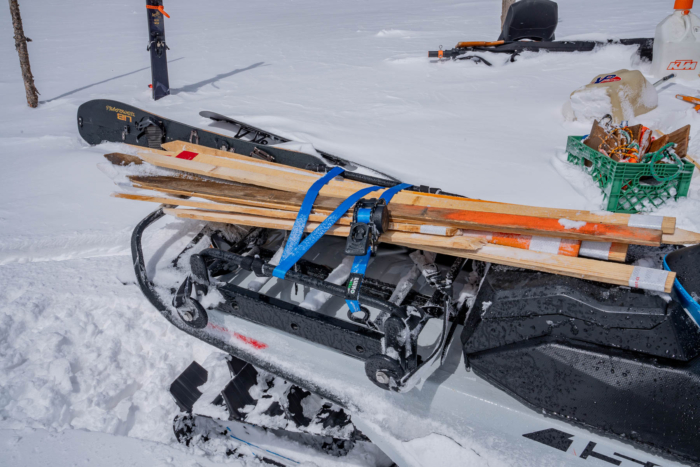
Buyer’s Guide: How to Choose Ratchet Straps
Most of us have to take our gear from our house to the outdoors. Keeping things tied down and secure helps preserve the life of your gear and keeps both people and objects safe. That’s where ratchet straps come in.
Ratchet straps include two foundational pieces: the straps and the ratchet. The ratchet is the metal centerpiece of the system that tightens, holds, and releases tension on the strap.
The straps are typically 1-inch wide and range wildly by length and there are various attachment styles. Within the ratchet, there are specific pieces that make the unit function. The handle design and release mechanism are two of the key differentiators.
Ratchets
Ratchets have two opposing sides — a flat base and a handle — that work by using teeth to catch and hold tension. The teeth are located on a round gear that rotates. Those apexes are uniformly placed but asymmetrical in shape, with one steep edge that the spring-loaded pawl grabs. While tightening the ratchet, the threaded strap rolls around the axle. This movement shortens and tightens the strap across the load.
You only really need to know that the system captures progress and holds tension.
Release System
The opposite is true for the release. Inside each side is a shorter release arm. When you want to release the tension, you slide your hand into each release arm, pull up, and widely spread the handle like opening a book. Pulling the handle open while simultaneously holding both release arms allows the ratchet to free up tension.
Nearly all ratchets have a manual design where the user must pull slack out of the system before tension can snag the strap. The exceptions are the Rhino Rack Retractable Ratchet Straps and Uline Retractable Tie Downs.
Retractable System
These novel systems offered by Rhino and Uline are a single housing (instead of the separate flat base and handle) and can be operated with a button for the tighten and release. The extra webbing is wound around a spring-powered coil. Pushing the button can release the slack (with a pull) or retract the strap, which brings the excess webbing back into the coil. From here, the system can be tightened like a normal hand-operated ratchet.
When you want to release the strap, just hit the button again. This retractable ratchet system is much easier and faster to use than a traditional design without the release-and-tighten button.
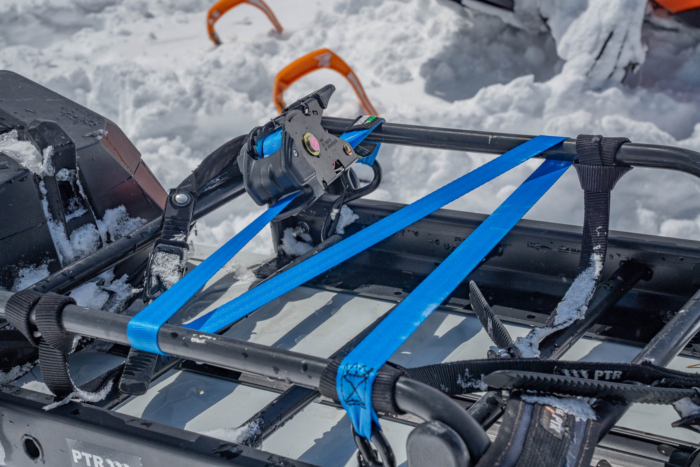
End Fittings
End fittings are where the webbing has an affixed attachment on the ends of the strap. These points are used to connect the webbing to the anchor and come in multiple forms.
The standard three end fittings are S-hook, S-hooks with a gate, and a flat snap hook.
S-hook
S-hook — with or without a gate — is the standard option. This design can be as simple as a wire hook with a rugged vinyl coating for added protection. The curvature, circumference, and overall size can range a bit.
Some S-hooks have a gate, which is a spring-loaded trap that allows the hook to be an enclosed circle around whatever its clipped to. Like insurance, it also keeps the S-hook from unfastening due to an abrupt jolt during transit.
Flat snap hook
A flat snap hook is a specific attachment style that is best used with an existing D-ring anchor. Similar to a gate, a broad yet slender chip swings backward then snaps closed upon release. This is a great alternative when the orientation of other attachment hooks would put a twist in the webbing.
The flat snap hook is the most secure in terms of preventing the strap from disconnecting even when slack develops in the system.
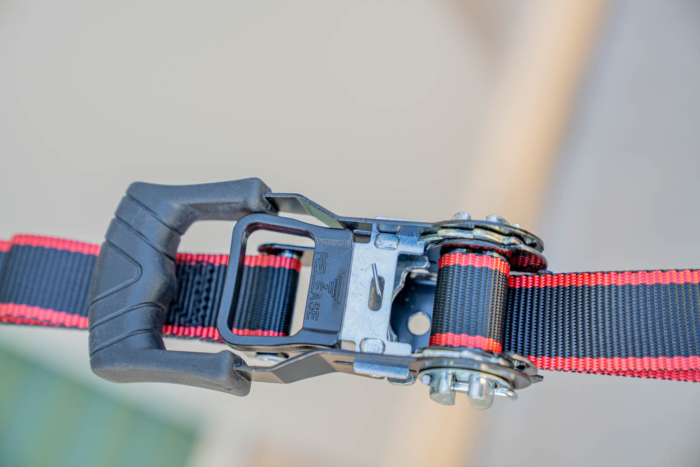
Soft Loops or Shackles
Soft loops are shorter webbing straps that can be used for girth hitching. A single shackle is looped around an object to create an anchor point that a hook would otherwise not be able to grab. Also called shackles, they can be used to prevent scratches on precious parts of gear like the shocks of a dirt bike.
Malleable and robust, shackles have a straight section of webbing with loops on each end, but one loop is straight while the other loop has a twist. First, you’ll thread the shackle around where it needs to be anchored with the two endpoints straddling that object. Simple and brilliant, you’ll feed the straight loop through the twisted loop and pull tight. The resulting anchor will have zero twists in the system. Now, a S-hook can grab the free side of the shackle.
Shackles are helpful if you need to wrap an anchor through the wheel and rim of your vehicle or around the handlebar of a bike, to name a couple examples. Soft loops simply open up customization for rigging anchors.
Both of the Rhino Ratchets — Rhino Rack Retractable Ratchet Straps and Rhino Rack HD Ratchet Tie-Down Set — as well as the Mac’s Custom Tie-Downs and Augo Heavy Duty Ratchet Tie-Down Straps come with soft loops included in the package. Those soft shackles are each rated for the same workload as their complimentary ratchet straps.
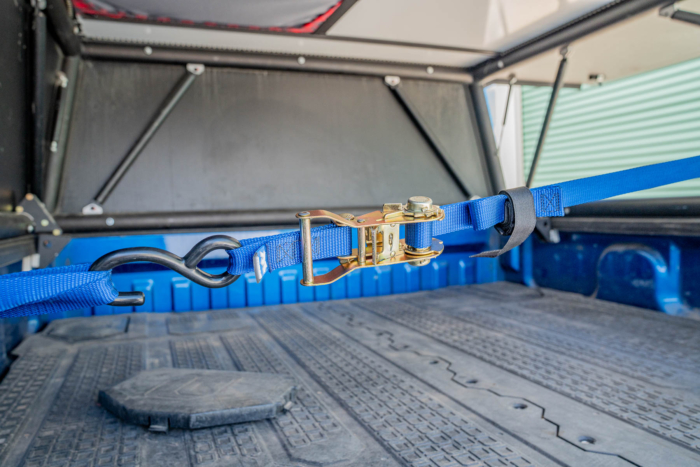
Materials
Ratchet straps are made of a few different materials.
The ratchet mechanism is made of steel. Some of the handles come with a rubber coating. The attachment S-hooks, with and without a gate, are built of steel with a vinyl coat. The webbing is typically manufactured from nylon, polyester, or a silk-polyester blend.
Nylon webbing — which comprises the Mac’s Custom Tie-Downs, for instance — has higher abrasion resistance compared to polyester but doesn’t do as well with water as the polyester webbing.
The water-absorption rate of nylon is higher than polyester, which leads to a lower tenacity, mold, or mildew. Furthermore, nylon can absorb more UV light, which accelerates the decomposition.
Generally, nylon is stronger in terms of breaking strength and working load but doesn’t hold up to the outdoor elements as much as polyester.
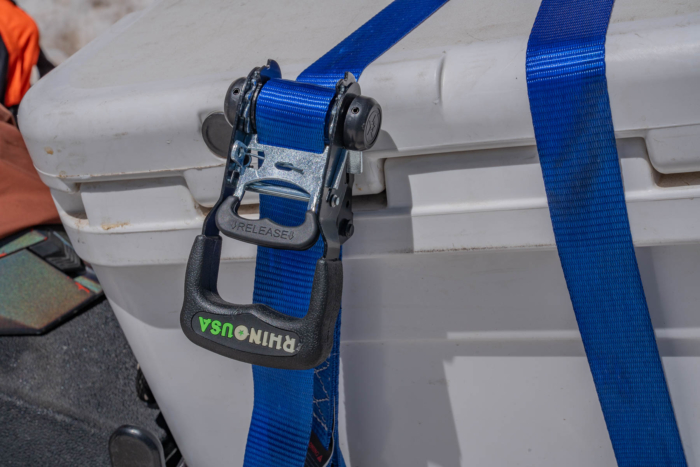
Breaking Strength & Working Load
When talking about load capacities of ratchet straps there are two crucial numbers: the breaking strength and the working load. They are both measured in pounds (lbs.) and can be easily confused. Let’s break the two terms down.
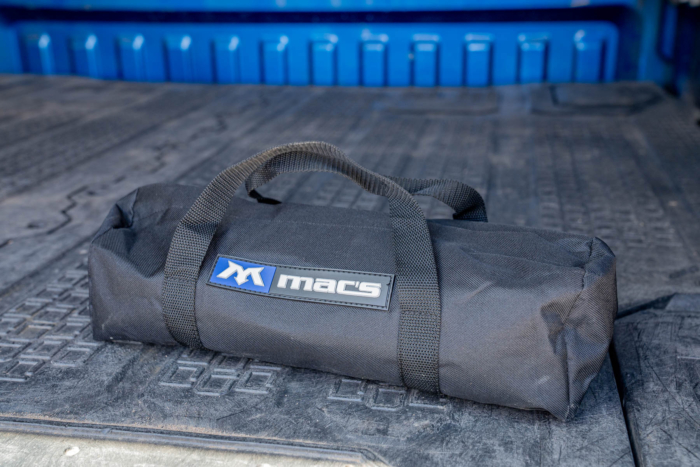
Breaking Strength
The breaking strength refers to the maximum weight that can be placed on the strap before the weakest point in the system fails.
Each part in a ratchet strap — from the S-hooks to the ratchet body to the webbing — has an individual breaking strength. The lowest number — or part that is most likely to fail first — sets the breaking strength for the entire system. For example, if the webbing is rated for 2,000 pounds but the S-hooks are only rated for 1,000 pounds, then the breaking strength of the entire ratchet strap would be 1,000 pounds.
If you’re hauling a hefty load, consider snagging the Rhino Rack HD Ratchet Tie-Down Set with a 5,260-pound breaking strength.
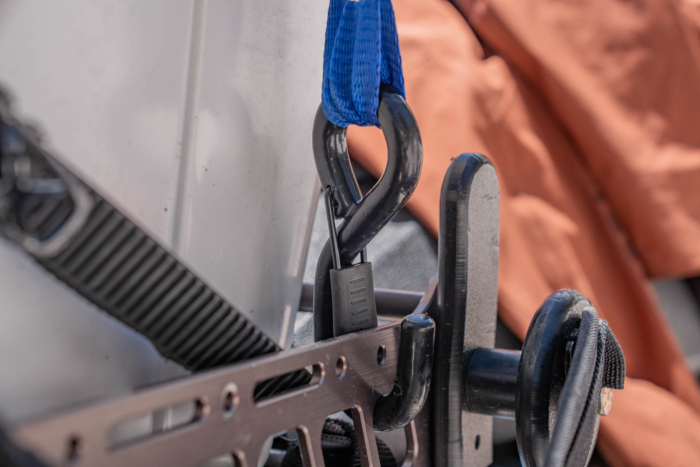
Working Load
A ratchet strap’s working load refers to the amount of weight that it can safely handle under normal conditions.
This number will always be smaller than the breaking strength. The working load is one-third of the breaking strength. To determine how much weight your ratchet strap can hold, check the working load. For example, to strap down a 1,000-pound motorcycle, you’ll need to use a ratchet strap that has a working load higher than 1,000 pounds.
On the lower end, the Husky Ratchet Tie-Downs 4-Pack offers a working load of 500 pounds, which is still suitable for a lot of applications.
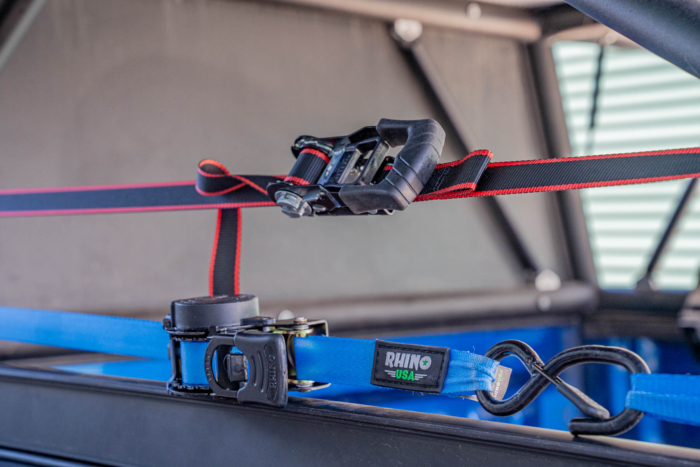
Price & Value
Ratchet straps are not one-size-fits-all, and the price tags reflect the range of materials, sizes, attachment points, tightening mechanisms, and customization of each set.
Budget
If you don’t need anything fancy, the Husky Ratchet Tie-Downs ($22) are a great basic tie-down that is very affordable. They do tend to show wear rather quickly but somehow manage to keep chugging along season after season doing exactly what they’re supposed to. The Augo Heavy Duty Ratchet Tie-Down Straps ($30) have a bit more capacity for only a few more dollars. This kit covers a very wide range of load sizes and is a compact design. However, they could use some Velcro to secure the end of the excess strap.
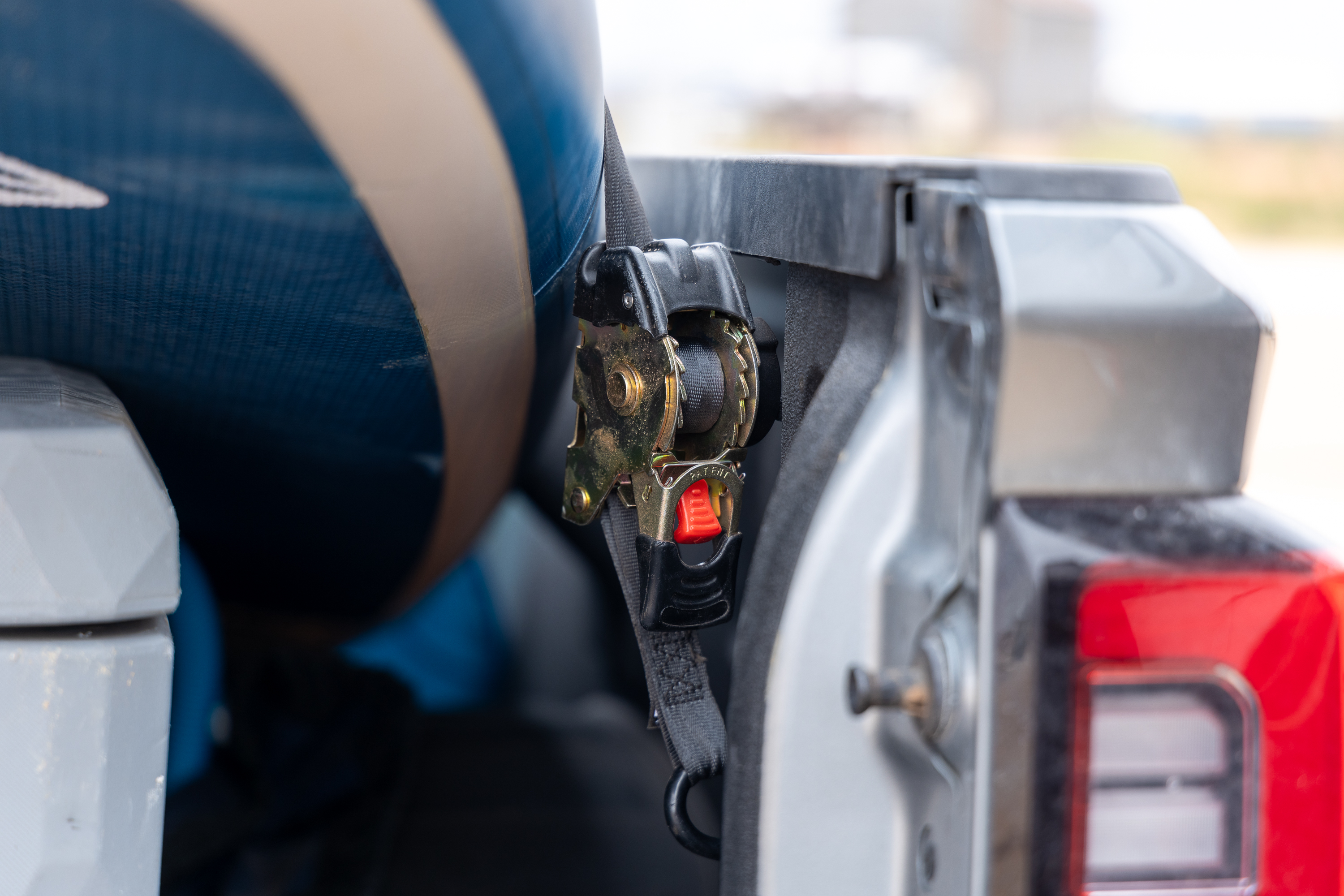
Mid-Tier
Bumping up 10 to 20 bucks, you’ll get ratchet straps with a higher breaking strength and, in some cases, a broader width and a higher workload limit. Certain designs also have higher-end textile blends and adjustment mechanisms like the silk-polyester Rhino Rack Retractable Ratchet Straps ($40). You’ll also find the US Cargo Control Ratchet Strap ($32), which offers a higher working load than the Rhino Retractable Straps, but the Rhino’s have the added convenience of the retractable mechanism.
Conversely, the US Cargo straps do not have rubberized handles and do not come with soft shackles or a storage bag. And the Rhino Retractables are a bit on the bulky side.
If this is within your price range and you need the extra capacity, the US cargo straps will serve you better. If you don’t need the extra capacity, the retractable system’s no-mess design might be right for you.
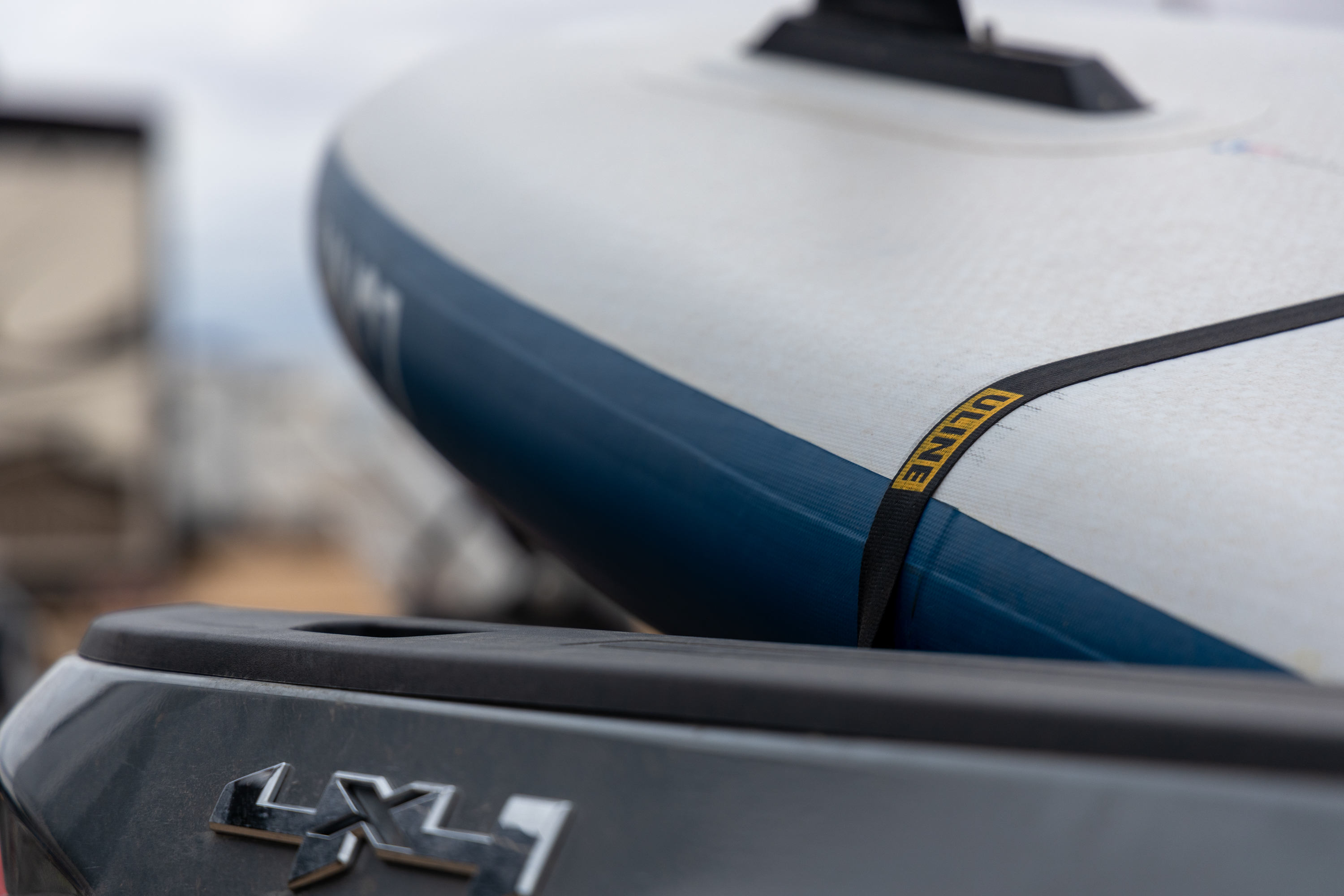
Premium
The uppermost price tag of our favorite straps is on the Mac’s Custom Tie-Downs ($80). While they are not retractable, you do get high quality materials and the benefit of being able to choose from three different end fittings, so you can really dial in the straps to your specific needs. We appreciate the customizable features including the length and color in addition to the attachment ends. Even more, the Mac’s has a whopping breaking strength of 2,800 pounds, so you’re seeing greater durability, performance, and strength the more tie-downs cost.
You’ll also find the Uline Retractable Tie Downs ($64) and Rhino Rack HD Ratchet Tie-Down Set ($60). The Uline straps offer a retractable system, while The Rhino straps will most certainly get the job done with the highest breaking strength of the entire test pool at 5,260 pounds.
All of these straps offer premium materials and construction. It comes down to a matter of what your specific needs are. Convenience? Consider the Uline straps. Versatility? Take a hard look at the Mac’s Tie-Downs. Strength? The Rhino straps will certainly fit the bill.
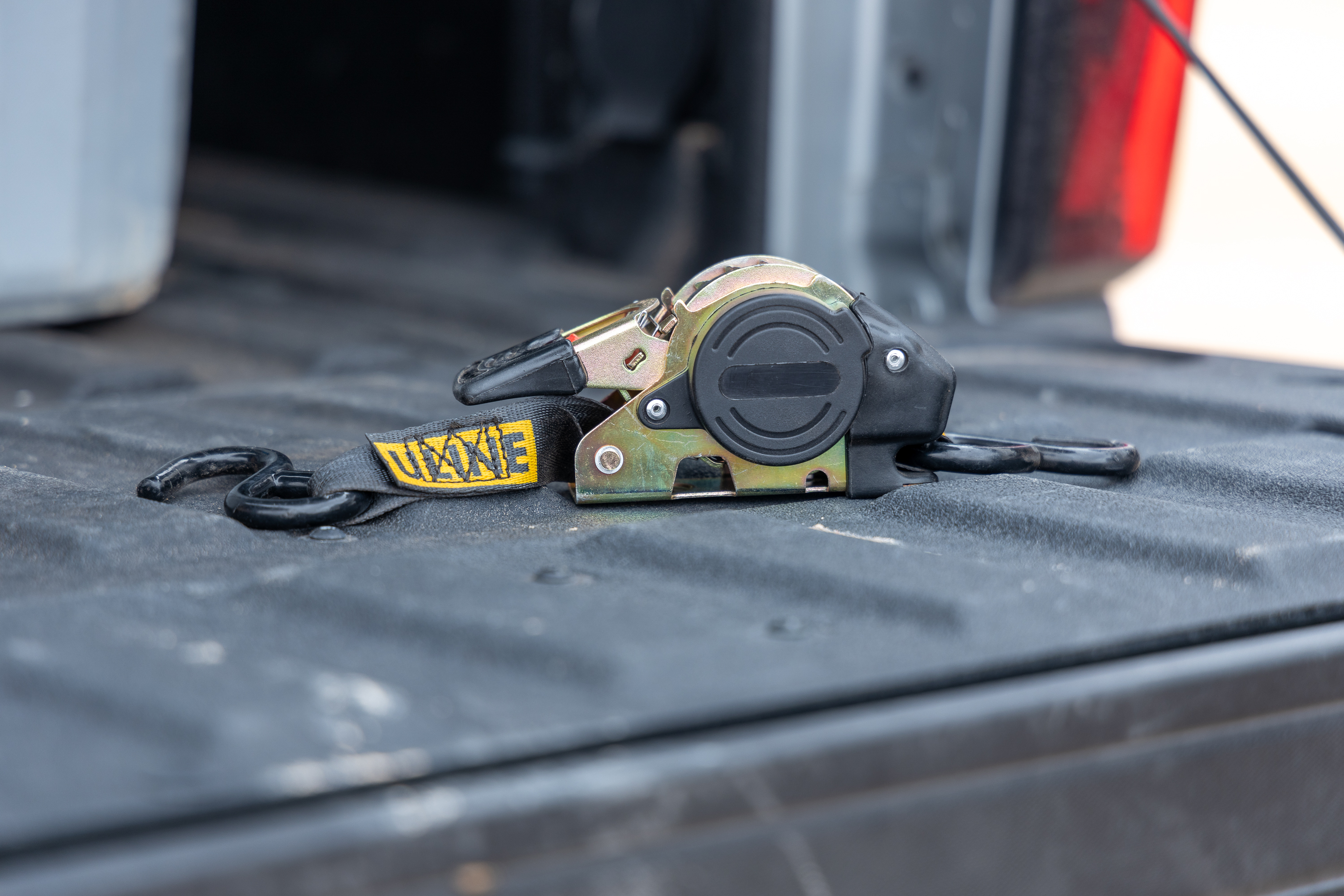
Frequently Asked Questions
Ratchet straps may look intimidating, but once you know how to work one, they are easy to use.
First, feed the strap through the rectangular slot in the center of the ratchet. Then, connect both S-hooks to your anchor points. Pull all of the slack out of the strap using your hands. Once the slack is out, use the handle of the ratchet to leverage and tighten the strap — you’ll hear a clicking of the pawl against the teeth — until the tension is totally tight with zero budget. Tie up any extra strap in the tail that may be hanging out, or use the quaint Velcro strap that’s sometimes included in a kit, and you’re good to go.
To release the ratchet strap, locate the interior release arms using a finger on both sides of the ratchet: the flat base and the handle. While pulling each release arm, fold the ratchet completely open like a book until the two parts are relatively flat, and then gently tug away from the anchor. The strap should now be loose.
Alternatively, there is a self-contained retractable design, such as the Rhino Rack Retractable Ratchet Straps and Uline Retractable Tie Downs, that offers a simple, straightforward operation without the fuss of excess webbing.
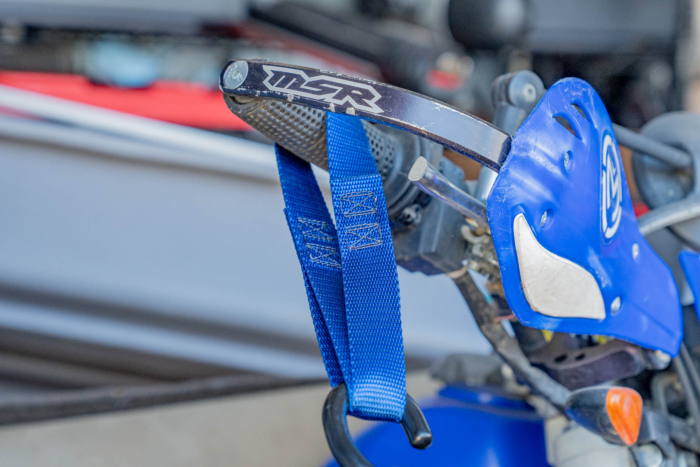
Each ratchet strap has its own safety instructions and load ratings. Never exceed the tie-down’s rated capacity, as it could break. Unplanned releases of the load could recoil with deadly force. Also, never use a tie-down for towing purposes, lifting, lowering, or suspending objects.
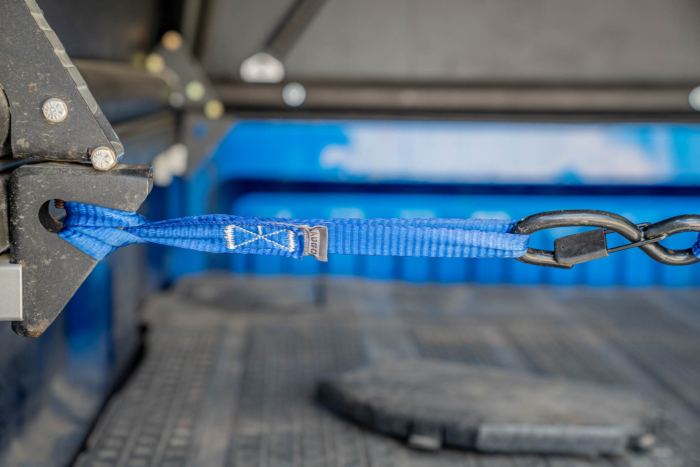
The use of ratchet straps on public roads and highways is legal as long as they are used correctly and remain within their working load capacity limits.
For instance, the U.S. Cargo Control Ratchet Strap meets the working load limits of a large list of entities, including the regulations of the Federal Motor Carrier Safety Administration (FMCSA) and Department of Transportation (DOT), guidelines of the Commercial Vehicle Safety Alliance (CVSA) and Web Sling and Tie Down Association (WSTDA), and the standards of the North American Cargo Securement.
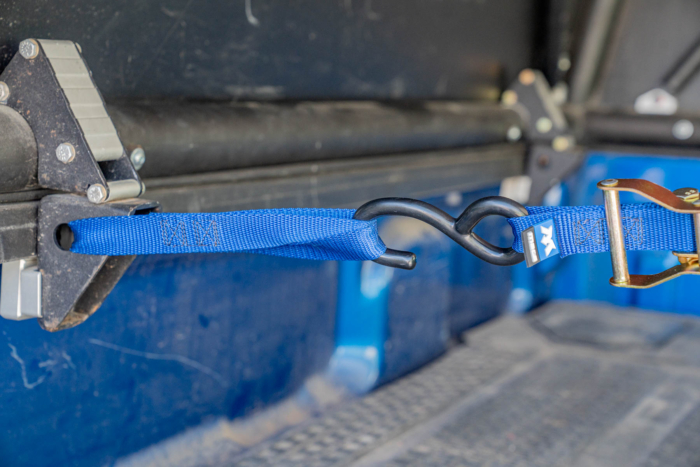
Environmental factors like sunlight, rain, snow, dirt, grit, or extreme changes in temperature can accelerate degradation of tie-downs. Additionally, abrasions, sharp surfaces, twisting, kinking, or knotting the tie-down could shorten the lifespan.
A heavily used or abused ratchet strap might only last a few months, while a properly stored and tactfully used tie-down might last up to a few years. Soft goods like the webbing used in tie-downs have a working lifespan of around five years.
Keep in mind, the lifespan will depend greatly on the cumulative hours of use, weather, and the environment. If you only pull out your ratchet straps for an overnight SUP trip every summer, that’s not a high volume of use.
Be sure to check the manufacturer’s guidelines for the lifespan, as well, and inspect your ratchet straps between uses. If you catch visible wear and tear like discoloration, holes, fraying, divots in the edge, mold, mildew, rusting, or disfigured plastic or metal then consider a replacement setup.
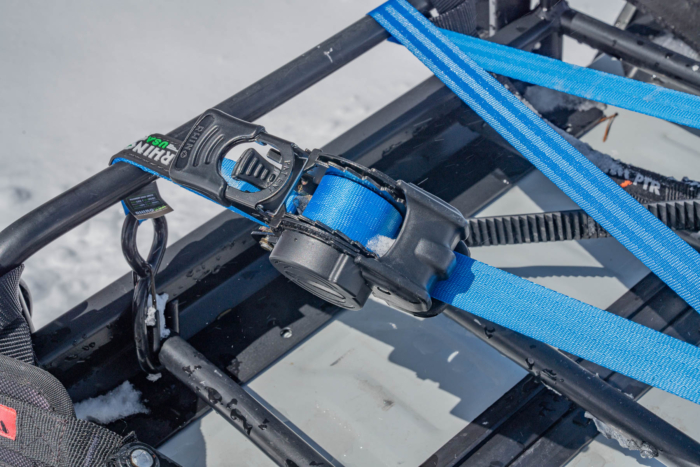
You’ll want to tighten each strap enough to safely and securely keep the cargo in place but not so tight that you begin to damage whatever cargo you are securing. You also do not want the straps to be so tight that it makes it nearly impossible to release the tension when removing the strap. This can sometimes make for a very unsafe, violent release that could be potentially harmful.
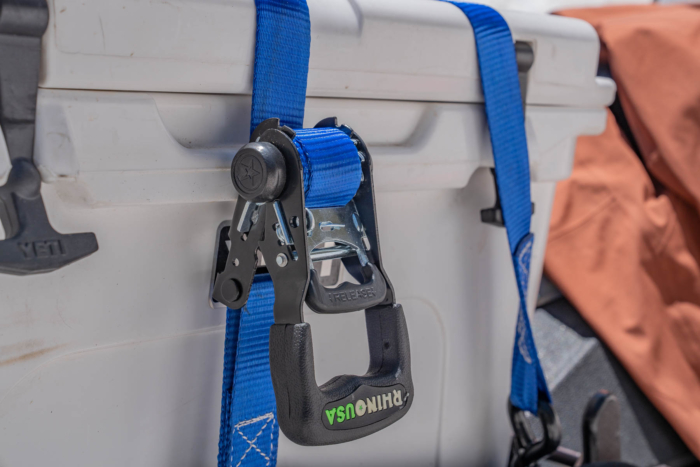
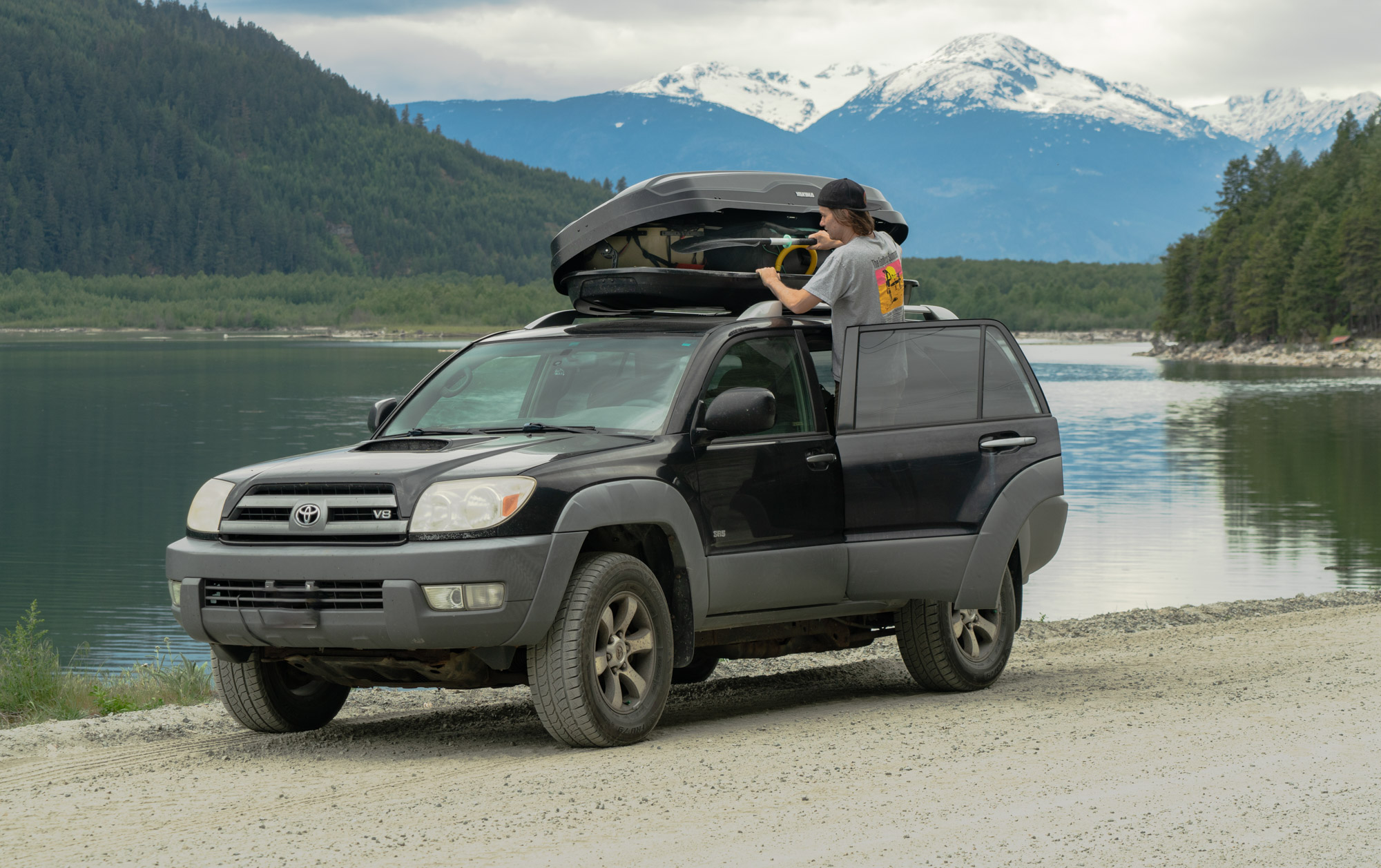
The Best Rooftop Cargo Boxes of 2025
Whether you’re road-tripping with the family or need to stow your camping gear, here are the best rooftop cargo boxes of 2025 from Thule, Yakima, and more!
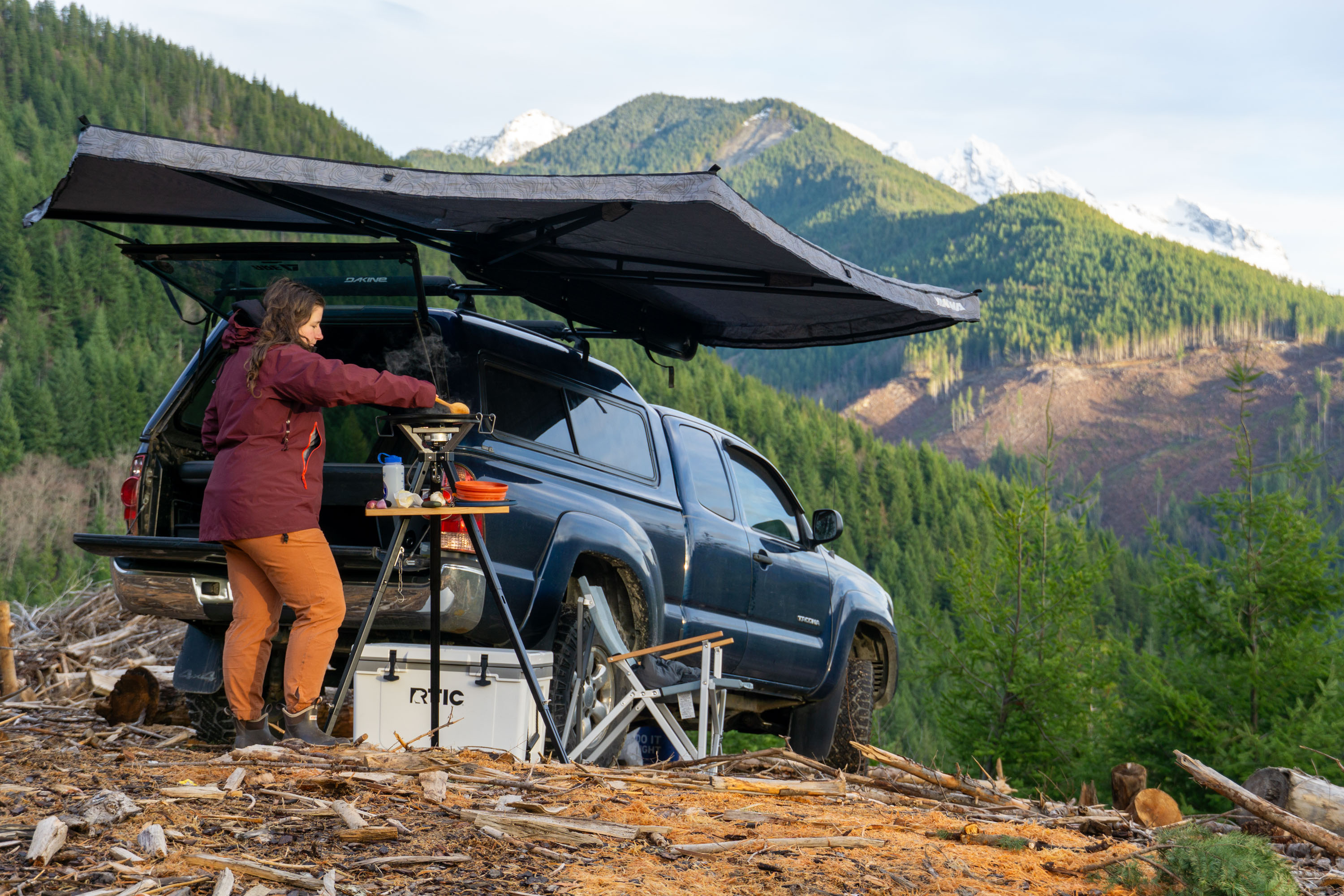
The Best Car and Truck Awnings of 2025
The best car and truck awnings offer pop-up shade and go-to shelter when inclement weather arises. Check out our top picks from Front Runner, Yakima, Roofnest, and more.
